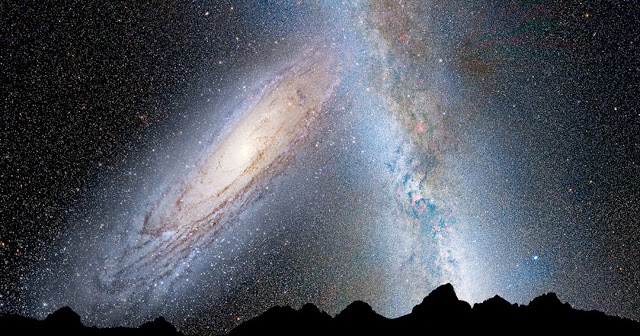- Get link
- Other Apps
- Get link
- Other Apps

The latest discovery of a massive halo of hot gas close to Andromeda Galaxy shows that our galaxies are already touching. Astronomers Nicholas Lehner from Notre Dame University led a team of researchers using the Hubble Space Telescope to observe a massive halo of hot, ionized gas about 2 million light years in diameter around the Andromeda galaxy,
The Andromeda and Milky Way Galaxy are the largest members of a ragtag group of about 54 galaxies, known as “the Local Group”. Andromeda Galaxy, with almost a trillion stars — twice as many as our Galaxy — shines 25% brighter and can easily be seen with the naked eye from outlying and countryside skies. If the recently discovered halo extends at least a million light years in our direction, Milky Way and Andromeda are way MUCH closer to collide than previously thought.
Lehner describes halos as the “gaseous atmospheres of galaxies”. Irrespective of its massive size, Andromeda’s nimbus is nearly invisible. To detect and study the halo, the Astrophysicists required quasars, distant star-like bodies that emit incredible amounts of energy as matter is sucked into the supermassive black holes. The brightest quasar, 3C273 in Virgo, can be easily detected with a 6-inch telescope!
Quasars’ bright, isolated nature makes them perfect probes. J. Christopher Howk, associate professor of physics at Notre Dame Institute and co-investigator, said:
As the light from the quasars travels toward Hubble Telescope, the halo’s gas will absorb some of that light and make the quasar look like a little darker in just a very small wavelength range,”. By measuring the decrease in brightness, we can tell how much halo gas from M31 there is between us and that particular quasar.
To detect Andromeda’s halo, Lehner and his team calculated how the light of 18 quasars (five shown above) was absorbed by the galaxy’s gas.
Astrophysicists have observed halos around 44 other galaxies but they never discovered it as massive as Andromeda where so many quasars are reachable to clearly outline its range. The other 44 were all very distant galaxies, with only a single quasar or data point to control halo size and structure. The halo is expected to contain half the mass of the stars in the Andromeda galaxy itself, in the form of a hot, rambling gas. Simulations suggest that it formed at the same time as the rest of the Andromeda.
Mostly consisting of ionized hydrogen — lone protons and electrons — Andromeda’s aura is remarkably rich in heavier elements, possibly provided by supernovae.
They explode inside the galaxy and violently blow noble stuff like iron, silicon, oxygen and other similar elements far into space. Previously Scientists stated that over Andromeda’s lifetime, almost half of all the heavy elements gathered by its stars have been discharged far outside the galaxy’s 200,000-light-year stellar disk. You can read the complete research paper here and Hubble’s release here. And next time on a clear night you look up to spot Andromeda Galaxy, remember this: it’s closer than you think!
Comments
Post a Comment